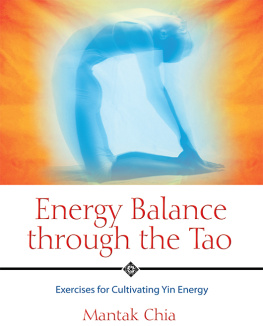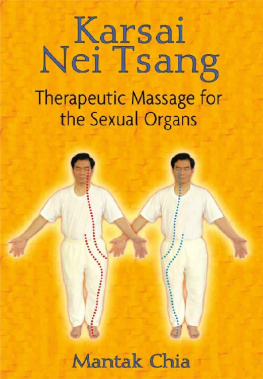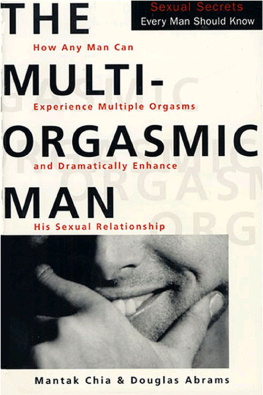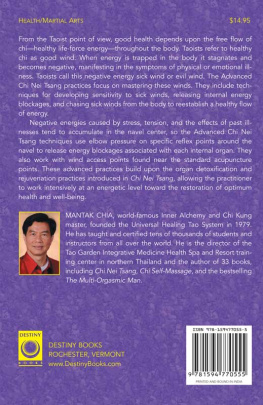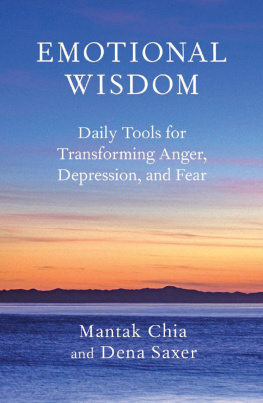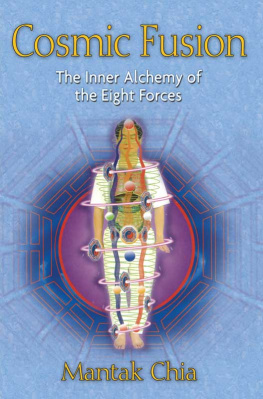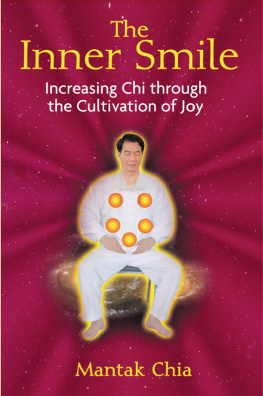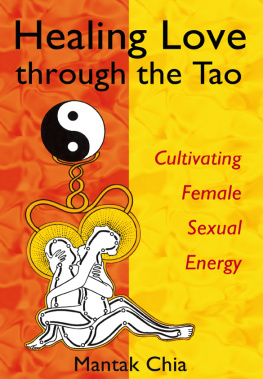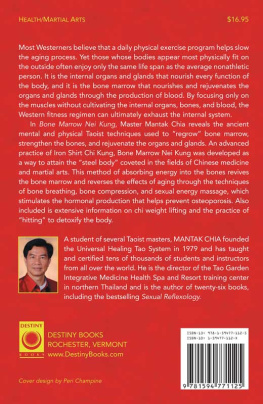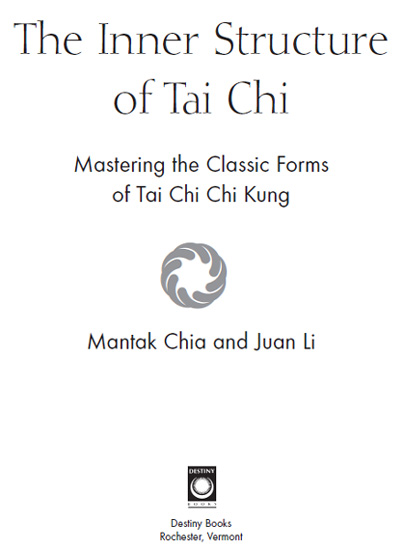
Acknowledgments
The Universal Tao Publications staff extend our gratitude to the many generations of Taoist Masters who have passed on their special lineage, in the form of an oral transmission, over thousands of years. We thank Taoist Master I Yun (Yi Eng) for his openness in transmitting the formulas of Taoist Inner Alchemy. We also thank Wu-style Tai Chi Master Edward Yee, who taught Master Chia the complete Tai Chi system; Tai Chi Master P. Y. Tam for the teaching of Tai Chi Chi Kung; and Master Cheng Yao-Lun for his teachings of Changing the Tendons and Sinews and Washing the Bone Marrow.
We offer our special thanks to Juan Li for his fine illustrations and for his preparation of the original draft of the first half of the manuscript. As always, he has played an integral role in presenting the Universal Tao concepts and techniques.
We express our deep appreciation to Jampa Mackenzie Stewart for his writing contributions and for his overall help in organizing and editing the first edition of this book, and we also thank Judith Stein, Kimberly Baldt, Dennis Lewis, Gary Oshinsky, Karl Danskin, Lynnette Brooks, and Michael Manelis for their assistance in editing and producing that edition. A special thank-you also goes to Saysunee Yongyod, photographer; Udon Jandee, illustrator; and Raruen Keawpadung for computer graphics.
We also wish to thank our editors at Inner Traditions, Susan Davidson and Vickie Trihy, as well as designer Priscilla Baker, for their valuable contributions to this new edition of Inner Structure of Tai Chi.
We offer our eternal gratitude to our parents and teachers for their many gifts to us. Remembering them brings joy and satisfaction to our continued efforts in presenting the Universal Tao System. As always, their contribution has been crucial in presenting the concepts and techniques of the Universal Tao. We wish to thank the thousands of unknown men and women of the Chinese healing arts who developed many of the methods and ideas presented in this book.
Putting Tai Chi Chi Kung into Practice
As you will read in the first chapter of this book, Tai Chi was originally developed as a martial art, with offensive and defensive movements. Nowadays Tai Chi is most often practiced as a moving meditation; in the Universal Tao practice of Tai Chi we focus on strengthening the internal body.
The practices described herein have been used for thousands of years by Taoists trained by personal instruction. When Tai Chi is practiced as a martial art, the degree of damage visited on ones opponent can range from harmless to lethal. The reader should practice movements taught in this book with great care and should not undertake these practices without also receiving personal instruction from a certified instructor of the Universal Tao. Universal Tao instructors can be located at our Web sites: www.universal-tao.com and www.taoinstructors.org.
The practices described herein are not intended to be used as an alternative or substitute for professional medical treatment and care. If a reader is suffering from a mental or emotional disorder, he or she should consult with an appropriate professional health care practitioner or therapist. Such problems should be corrected before one starts training. People who have high blood pressure, heart disease, or a generally weak condition should proceed cautiously, having received prior consent from a qualified medical practitioner.
The Universal Tao and its staff and instructors cannot be responsible for the consequences of any practice or misuse of the information in this book. If the reader undertakes any exercise without strictly following the instructions, notes, and warnings, the responsibility must lie solely with the reader.
Foreword
JAMPA MACKENZIE STEWART, OMD
SENIOR UNIVERSAL TAO INSTRUCTOR
I had been practicing and teaching Tai Chi for about ten years when I first met Master Mantak Chia in 1982. I had already learned Old Chen style, Yang style, Wu style, Cheng Man-Ching style, and Twenty-Four style Tai Chi. In fact, I knew so many different Tai Chi forms that I could not practice them all in one day.
For years I had read books about the mysterious inner changes that were supposed to take place as a result of Tai Chi practicetransforming sexual energy into chi and chi into spirit. Yet the Tai Chi teachers I studied with either didnt know about these practices or wouldnt divulge their knowledge. While I practiced hard what I had been taught, I was frustrated by the snails pace at which I seemed to be progressing. I was elated to finally find Mantak Chia, a true Taoist master who was openly teaching the esoteric secrets of Taoist inner alchemy.
Still, the last thing I wanted to learn was another Tai Chi form! When I first saw Master Chias Tai Chi Chi Kung form, there seemed to be nothing to itonly Grasping the Birds Tail and Single Whip. I already knew five different ways of doing these movements. I was therefore able to learn Master Chias form in one day. Or so I thought.
I was quite proud of my Tai Chi when I went to the Catskill Mountains in upstate New York for Master Chias teacher training retreat in the summer of 1986. Master Chia required that all his instructors learn Tai Chi Chi Kung as a prerequisite for teaching the higher-level practices of the Universal Tao. No sweat, I thought. My years of prior training will stand me in good stead.
What a rude and humiliating awakening I was in for! Master Chia was merciless with me and brutally frank in his assessment of my Tai Chi. You barely passed, he told me. How can you practice Tai Chi for so many years and still have no root? Each successive year thereafter he would say to me, You still dont get it! No spinal cord power. No spiraling. If you teach Tai Chi you have to know these things.
How could there be so much to master in so short a form?
It slowly dawned on me, through the veils of my stubborn pride and tenacious ignorance, that Tai Chi has nothing to do with the number of moves one learns or the different styles one knowsits the quality of each movement that counts. When a student understands the profound principles of body mechanics, energy transfer, and mental focus that have been preserved within Tai Chi from the earliest masters down to the present, then everything that student does is Tai Chi. On the other hand, if you dont grasp the principles of inner structure, then although your Tai Chi movements may look beautiful, your form is empty and hollow.
Western boxing has only about five techniques, yet consider how difficult it is to become a champion boxer like Muhammad Ali or Mike Tyson. Tai Chi has thirteen basic techniques as well as hundreds of inner principles of movement. The simple form of Tai Chi Chi Kung contains them all.
With fewer outer movements to perform, the Tai Chi Chi Kung student quickly progresses from the initial stage of learning the outer form to the stage of mastering the inner structure of Tai Chi. I had to grudgingly admit that Master Chias students, who had studied Tai Chi Chi Kung with him for only three intensive weeks, were further along than my students who had studied the longer Tai Chi forms over two or three years!
Most other traditional Tai Chi masters required their students to train in Tai Chi for years before they exposed them to internal energy work such as the Microcosmic Orbit Meditation. After years of devoted study and service, the master would secretly take the fortunate and diligent student into his inner sanctum and reward him by teaching him the Microcosmic Orbit as the crowning initiation in his training. Part of Master Chias genius is his insistence that students learn the Microcosmic Orbit meditation and Iron Shirt Chi Kung at the outset, as prerequisites to Tai Chi Chi Kung.
Next page

